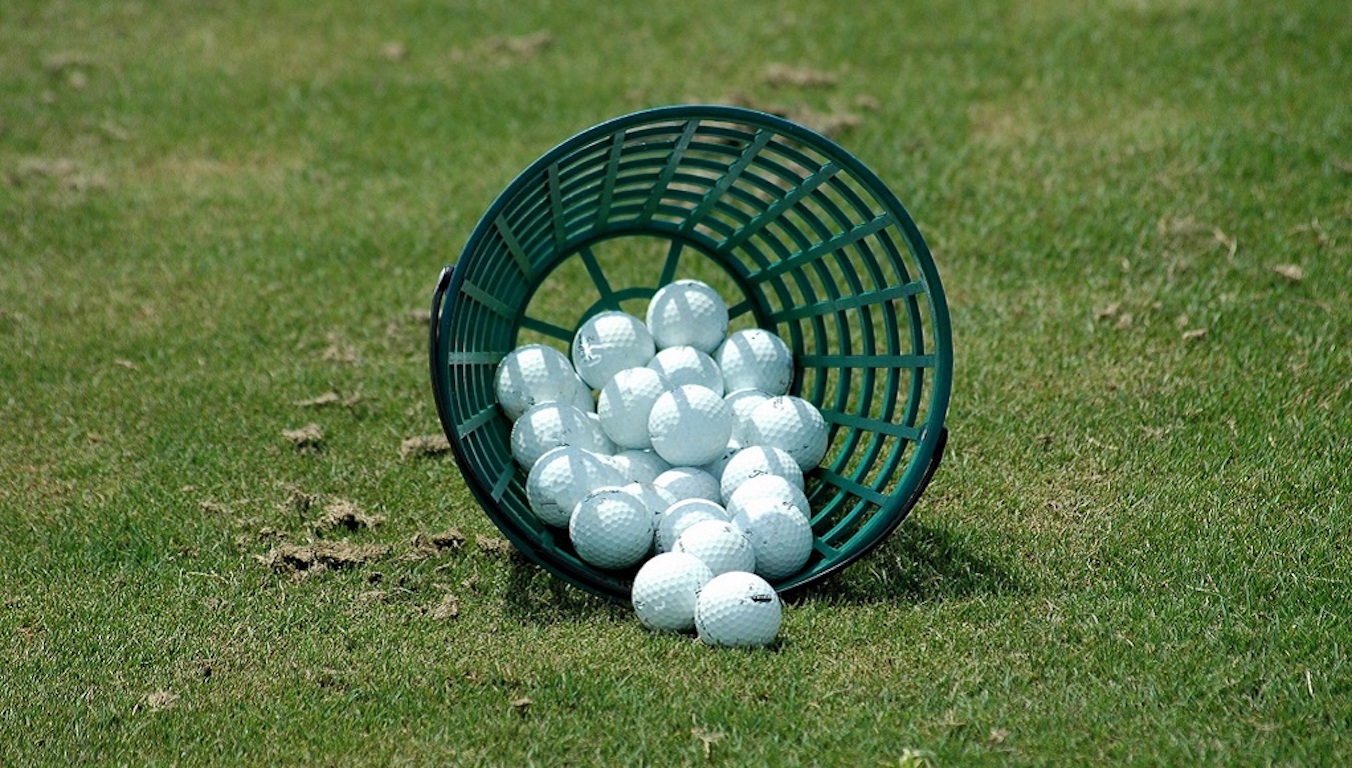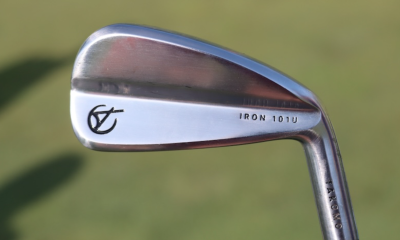Opinion & Analysis
No. 17 at TPC Sawgrass: Love it or hate it?

By the numbers, No. 17 on The Players Stadium at TPC Sawgrass would rank as one of the least remarkable holes on the PGA Tour.
It measures just 130 yards and is one of the largest greens on the golf course — a combination that would ordinarily invite a barrage of birdies at most tour stops.
Except The Players Championship isn’t most Tour stops, and No. 17 isn’t any ordinary hole.
Over the years, the notorious island green has taken countless dreams of winning the Tour’s richest prize and buried them in a watery grave. It’s for that reason that No. 17, which requires nothing more than a straightforward wedge, has the uncanny ability to haunt the world’s best players before they even set foot on the first tee.
For proof, during NBC’s coverage of The Players, notice how many times it replays someone sneaking a glimpse of the island while standing in the 16th fairway.
Combine the mind games of No. 17 with the spectator-friendly design of TPC Sawgrass’ The Stadium Course and what you have is perhaps the best theater in all of golf.
Every fan can surely agree that the atmosphere surrounding the 17th on Sunday at The Players is one of the most dramatic and raucous in the game. Where many of us disagree, however, is our opinion of the hole itself.
There are two schools of thought when it comes to the island green: love and hate. The lovers defend the 17th as a pure test of golf. Execute a relatively easy shot, or pay the ultimate price. Plain and simple.
The haters, on the other hand, decry the island green as a tacky abomination, and curse Pete Dye’s sick sense of humor. They argue a significant number of golfers are defeated before they even arrive, a fate that seems contrary to the spirit of this beautiful game.
I’ve been fortunate to tee it up on the 17th three times, and managed to find dry land — plus Old Man Par — on every occasion. Despite this string of good luck, however, I would have to align myself as a hater.
Yes, I love the drama that the 17th brings to Sunday at The Players, but the purist in me firmly believes that a truly great hole gives the golfer multiple ways to make par. With an island green, there’s only one.
But I’m just a lowly weekend warrior with a laptop. What do you think?
- LIKE2
- LEGIT0
- WOW0
- LOL0
- IDHT0
- FLOP0
- OB0
- SHANK0
19th Hole
Vincenzi’s LIV Golf Singapore betting preview: Course specialist ready to thrive once again

After another strong showing in Australia, LIV Golf will head to Sentosa Golf Club in Singapore looking to build off of what was undoubtedly their best event to date.
Sentosa Golf Club sits on the southern tip of Singapore and is one of the most beautiful courses in the world. The course is more than just incredible scenically; it was also rated 55th in Golf Digest’s top-100 courses in 2022-2023 and has been consistently regarded as one of the best courses in Asia. Prior to being part of the LIV rotation, the course hosted the Singapore Open every year since 2005.
Sentosa Golf Club is a par 71 measuring 7,406 yards. The course will require precise ball striking and some length off the tee. It’s possible to go low due to the pristine conditions, but there are also plenty of hazards and difficult spots on the course that can bring double bogey into play in a hurry. The Bermudagrass greens are perfectly manicured, and the course has spent millions on the sub-air system to keep the greens rolling fast. I spoke to Asian Tour player, Travis Smyth, who described the greens as “the best [he’s] ever played.”
Davis Love III, who competed in a Singapore Open in 2019, also gushed over the condition of the golf course.
“I love the greens. They are fabulous,” the 21-time PGA Tour winner said.
Love III also spoke about other aspects of the golf course.
“The greens are great; the fairways are perfect. It is a wonderful course, and it’s tricky off the tee.”
“It’s a long golf course, and you get some long iron shots. It takes somebody hitting it great to hit every green even though they are big.”
As Love III said, the course can be difficult off the tee due to the length of the course and the trouble looming around every corner. It will take a terrific ball striking week to win at Sentosa Golf Club.
In his pre-tournament press conference last season, Phil Mickelson echoed many of the same sentiments.
“To play Sentosa effectively, you’re going to have a lot of shots from 160 to 210, a lot of full 6-, 7-, 8-iron shots, and you need to hit those really well and you need to drive the ball well.”
Golfers who excel from tee to green and can dial in their longer irons will have a massive advantage this week.
Stat Leaders at LIV Golf Adelaide:
Fairways Hit
1.) Louis Oosthuizen
2.) Anirban Lahiri
3.) Jon Rahm
4.) Brendan Steele
5.) Cameron Tringale
Greens in Regulation
1.) Brooks Koepka
2.) Brendan Steele
3.) Dean Burmester
4.) Cameron Tringale
5.) Anirban Lahiri
Birdies Made
1.) Brendan Steele
2.) Dean Burmester
3.) Thomas Pieters
4.) Patrick Reed
5.) Carlos Ortiz
LIV Golf Individual Standings:
1.) Joaquin Niemann
2.) Jon Rahm
3.) Dean Burmester
4.) Louis Oosthuizen
5.) Abraham Ancer
LIV Golf Team Standings:
1.) Crushers
2.) Legion XIII
3.) Torque
4.) Stinger GC
5.) Ripper GC
LIV Golf Singapore Picks
Sergio Garcia +3000 (DraftKings)
Sergio Garcia is no stranger to Sentosa Golf Club. The Spaniard won the Singapore Open in 2018 by five strokes and lost in a playoff at LIV Singapore last year to scorching hot Talor Gooch. Looking at the course setup, it’s no surprise that a player like Sergio has played incredible golf here. He’s long off the tee and is one of the better long iron players in the world when he’s in form. Garcia is also statistically a much better putter on Bermudagrass than he is on other putting surfaces. He’s putt extremely well on Sentosa’s incredibly pure green complexes.
This season, Garcia has two runner-up finishes, both of them being playoff losses. Both El Camaleon and Doral are courses he’s had success at in his career. The Spaniard is a player who plays well at his tracks, and Sentosa is one of them. I believe Sergio will get himself in the mix this week. Hopefully the third time is a charm in Singapore.
Paul Casey +3300 (FanDuel)
Paul Casey is in the midst of one of his best seasons in the five years or so. The results recently have been up and down, but he’s shown that when he’s on a golf course that suits his game, he’s amongst the contenders.
This season, Casey has finishes of T5 (LIV Las Vegas), T2 (LIV Hong Kong), and a 6th at the Singapore Classic on the DP World Tour. At his best, the Englishman is one of the best long iron players in the world, which makes him a strong fit for Sentosa. Despite being in poor form last season, he was able to fire a Sunday 63, which shows he can low here at the course.
It’s been three years since Casey has won a tournament (Omega Dubai Desert Classic in 2021), but he’s been one of the top players on LIV this season and I think he can get it done at some point this season.
Mito Pereira +5000 (Bet365)
Since Mito Pereira’s unfortunate demise at the 2022 PGA Championship, he’s been extremely inconsistent. However, over the past few months, the Chilean has played well on the International Series as well as his most recent LIV start. Mito finished 8th at LIV Adelaide, which was his best LIV finish this season.
Last year, Pereira finished 5th at LIV Singapore, shooting fantastic rounds of 67-66-66. It makes sense why Mito would like Sentosa, as preeminent ball strikers tend to rise to the challenge of the golf course. He’s a great long iron player who is long and straight off the tee.
Mito has some experience playing in Asia and is one of the most talented players on LIV who’s yet to get in the winner’s circle. I have questions about whether or not he can come through once in contention, but if he gets there, I’m happy to roll the dice.
Andy Ogletree +15000 (DraftKings)
Andy Ogletree is a player I expected to have a strong 2024 but struggled early in his first full season on LIV. After failing to crack the top-25 in any LIV event this year, the former U.S. Amateur champion finally figured things out, finished in a tie for 3rd at LIV Adelaide.
Ogletree should be incredible comfortable playing in Singapore. He won the International Series Qatar last year and finished T3 at the International Series Singapore. The 26-year-old was arguably the best player on the Asian Tour in 2023 and has been fantastic in the continent over the past 18 months.
If Ogletree has indeed found form, he looks to be an amazing value at triple-digit odds.
- LIKE3
- LEGIT3
- WOW1
- LOL2
- IDHT0
- FLOP2
- OB0
- SHANK0
Opinion & Analysis
Ryan: Lessons from the worst golf instructor in America

In Tampa, there is a golf course that boasts carts that do not work, a water range, and a group of players none of which have any chance to break 80. The course is overseen by a staff of crusty men who have succeeded at nothing in life but ending up at the worst-run course in America. However, this place is no failure. With several other local courses going out of business — and boasting outstanding greens — the place is booked full.
While I came for the great greens, I stayed to watch our resident instructor; a poor-tempered, method teacher who caters to the hopeless. At first, it was simply hilarious. However, after months of listening and watching, something clicked. I realized I had a front-row seat to the worst golf instructor in America.
Here are some of my key takeaways.
Method Teacher
It is widely accepted that there are three types of golf instructors: system teachers, non-system teachers, and method teachers. Method teachers prescribe the same antidote for each student based on a preamble which teachers can learn in a couple day certification.
Method teaching allows anyone to be certified. This process caters to the lowest caliber instructor, creating the illusion of competency. This empowers these underqualified instructors with the moniker of “certified” to prey on the innocent and uninformed.
The Cult of Stack and Jilt
The Stack and Tilt website proudly boasts, “A golfer swings his hands inward in the backswing as opposed to straight back to 1) create power, similar to a field goal kicker moving his leg in an arc and 2) to promote a swing that is in-to-out, which produces a draw (and eliminates a slice).”
Now, let me tell you something, there is this law of the universe which says “energy can either be created or destroyed,” so either these guys are defying physics or they have no idea what they are taking about. Further, the idea that the first move of the backswing determines impact is conjecture with a splash of utter fantasy.
These are the pontifications of a method — a set of prescriptions applied to everyone with the hope of some success through the placebo effect. It is one thing for a naive student to believe, for a golf instructor to drink and then dispel this Kool-Aid is malpractice.
Fooled by Randomness
In flipping a coin, or even a March Madness bet, there is a 50-50 chance of success. In golf, especially for new players, results are asymmetric. Simply put: Anything can happen. The problem is that when bad instructors work with high handicappers, each and every shot gets its own diagnosis and prescription. Soon the student is overwhelmed.
Now here’s the sinister thing: The overwhelming information is by design. In this case, the coach is not trying to make you better, they are trying to make you reliant on them for information. A quasi Stockholm syndrome of codependency.
Practice
One of the most important scientists of the 20th century was Ivan Pavlov. As you might recall, he found that animals, including humans, could be conditioned into biological responses. In golf, the idea of practice has made millions of hackers salivate that they are one lesson or practice session from “the secret.”
Sunk Cost
The idea for the worst golf instructor is to create control and dependency so that clients ignore the sunk cost of not getting better. Instead, they are held hostage by the idea that they are one lesson or tip away from unlocking their potential.
Cliches
Cliches have the effect of terminating thoughts. However, they are the weapon of choice for this instructor. Add some hyperbole and students actually get no information. As a result, these players couldn’t play golf. When they did, they had no real scheme. With no idea what they are doing, they would descend into a spiral of no idea what to do, bad results, lower confidence, and running back to the lesson tee from more cliches.
The fact is that poor instruction is about conditioning players to become reliant members of your cult. To take away autonomy. To use practice as a form of control. To sell more golf lessons not by making people better but through the guise that without the teacher, the student can never reach their full potential. All under the umbrella of being “certified” (in a 2-day course!) and a melee of cliches.
This of course is not just happening at my muni but is a systemic problem around the country and around the world, the consequences of which are giving people a great reason to stop playing golf. But hey, at least it’s selling a lot of golf balls…
- LIKE17
- LEGIT1
- WOW0
- LOL4
- IDHT1
- FLOP0
- OB0
- SHANK17
19th Hole
Vincenzi’s 2024 Zurich Classic of New Orleans betting preview

The PGA TOUR heads to New Orleans to play the 2023 Zurich Classic of New Orleans. In a welcome change from the usual stroke play, the Zurich Classic is a team event. On Thursday and Saturday, the teams play best ball, and on Friday and Sunday the teams play alternate shot.
TPC Louisiana is a par 72 that measures 7,425 yards. The course features some short par 4s and plenty of water and bunkers, which makes for a lot of exciting risk/reward scenarios for competitors. Pete Dye designed the course in 2004 specifically for the Zurich Classic, although the event didn’t make its debut until 2007 because of Hurricane Katrina.
Coming off of the Masters and a signature event in consecutive weeks, the field this week is a step down, and understandably so. Many of the world’s top players will be using this time to rest after a busy stretch.
However, there are some interesting teams this season with some stars making surprise appearances in the team event. Some notable teams include Patrick Cantlay and Xander Schauffele, Rory McIlroy and Shane Lowry, Collin Morikawa and Kurt Kitayama, Will Zalatoris and Sahith Theegala as well as a few Canadian teams, Nick Taylor and Adam Hadwin and Taylor Pendrith and Corey Conners.
Past Winners at TPC Louisiana
- 2023: Riley/Hardy (-30)
- 2022: Cantlay/Schauffele (-29)
- 2021: Leishman/Smith (-20)
- 2019: Palmer/Rahm (-26)
- 2018: Horschel/Piercy (-22)
- 2017: Blixt/Smith (-27)
2024 Zurich Classic of New Orleans Picks
Tom Hoge/Maverick McNealy +2500 (DraftKings)
Tom Hoge is coming off of a solid T18 finish at the RBC Heritage and finished T13 at last year’s Zurich Classic alongside Harris English.
This season, Hoge is having one of his best years on Tour in terms of Strokes Gained: Approach. In his last 24 rounds, the only player to top him on the category is Scottie Scheffler. Hoge has been solid on Pete Dye designs, ranking 28th in the field over his past 36 rounds.
McNealy is also having a solid season. He’s finished T6 at the Waste Management Phoenix Open and T9 at the PLAYERS Championship. He recently started working with world renowned swing coach, Butch Harmon, and its seemingly paid dividends in 2024.
Keith Mitchell/Joel Dahmen +4000 (DraftKings)
Keith Mitchell is having a fantastic season, finishing in the top-20 of five of his past seven starts on Tour. Most recently, Mitchell finished T14 at the Valero Texas Open and gained a whopping 6.0 strokes off the tee. He finished 6th at last year’s Zurich Classic.
Joel Dahmen is having a resurgent year and has been dialed in with his irons. He also has a T11 finish at the PLAYERS Championship at TPC Sawgrass which is another Pete Dye track. With Mitchell’s length and Dahmen’s ability to put it close with his short irons, the Mitchell/Dahmen combination will be dangerous this week.
Taylor Moore/Matt NeSmith +6500 (DraftKings)
Taylor Moore has quickly developed into one of the more consistent players on Tour. He’s finished in the top-20 in three of his past four starts, including a very impressive showing at The Masters, finishing T20. He’s also finished T4 at this event in consecutive seasons alongside Matt NeSmith.
NeSmith isn’t having a great 2024, but has seemed to elevate his game in this format. He finished T26 at Pete Dye’s TPC Sawgrass, which gives the 30-year-old something to build off of. NeSmith is also a great putter on Bermudagrass, which could help elevate Moore’s ball striking prowess.
- LIKE8
- LEGIT3
- WOW1
- LOL1
- IDHT0
- FLOP3
- OB1
- SHANK2
-

 19th Hole2 weeks ago
19th Hole2 weeks agoJustin Thomas on the equipment choice of Scottie Scheffler that he thinks is ‘weird’
-

 19th Hole1 week ago
19th Hole1 week ago‘Absolutely crazy’ – Major champ lays into Patrick Cantlay over his decision on final hole of RBC Heritage
-

 19th Hole3 weeks ago
19th Hole3 weeks agoTwo star names reportedly blanked Jon Rahm all week at the Masters
-

 19th Hole2 weeks ago
19th Hole2 weeks agoReport: LIV Golf identifies latest star name they hope to sign to breakaway tour
-

 19th Hole3 weeks ago
19th Hole3 weeks agoNeal Shipley presser ends in awkward fashion after reporter claims Tiger handed him note on 8th fairway
-

 19th Hole2 weeks ago
19th Hole2 weeks agoBrandel Chamblee has ‘no doubt’ who started the McIlroy/LIV rumor and why
-

 Equipment3 weeks ago
Equipment3 weeks agoWhat we know about Bryson DeChambeau’s 3D-printed Avoda irons
-

 19th Hole6 days ago
19th Hole6 days agoLET pro gives detailed financial breakdown of first week on tour…and the net result may shock you


















8thehardway
May 8, 2013 at 2:39 pm
From the pgatour website
No. 17 has yielded 518 three-putts or worse since 1992, the second most of any non-major hole on the PGA TOUR
least/most water balls
29 (2003, 2010) / 93 (2007)
I guess it comes down to how you like your adrenaline. For me it’s a matter of balance; No. 17 places too much emphasis on one hole and isn’t in keeping with the rest of the layout.
As a matter of balance, 17 forces ; were the course out of balance
Gary Lee
May 8, 2013 at 12:29 pm
The 17th is a great finishing hole for a tornament. I played it once and birdied it.
Dudley
May 8, 2013 at 11:32 am
From an architecture standpoint, I really do not see what is great about the #17th hole at TPC. A green in the middle of a lake….what is so genius about that? In golf terms, I guess it comes under the category of going to a auto race to see a wreck….watching PGA golf pros hit their ball into the water. A sign of the times…good for TV golf…..but there are 17 other holes and some of them are great architecture….#17 is not one of them….
David
May 7, 2013 at 4:37 pm
It’s exiting of course, but its a bad hole.
Up and downs after missing a green can be just as thrilling if not more.
Puddin
May 7, 2013 at 4:21 pm
Anyone have the stat for “in the water” vs. “on the green”? Pros or amateurs? I played there once in a company outing and 1 out 10 hit the green that day out of 40 players. Curious to know over the years what the Pros percentage is.
Chris
May 7, 2013 at 1:08 pm
D.J. fun article.
#17 is the defining hole on this course and I love the drama. If I were lucky enough to play TPC Sawgrass 17 would be on my mind all day and it would also be the first thing I would tell everyone about after my round.
Golf IS a complete head game, especially at the Pro level. We’ve all weak wristed chips, choked on short puts and have holes that own us before the round even starts. Being able to overcome and produce when our mind is trying to hold us back is one of the best parts of golf.
In the modern game it’s seems a stretch for anyone to be a purist anymore. Short putter vs Long putter, GPS vs Walking yardages, over sized drivers, super charged “premium balls,” Wedge grove size etc.
Technology allows all of us to potentially play better, the emotional aspect is what keeps us all in check.
D.J. - The World of Deej
May 7, 2013 at 4:39 pm
Definitely a very good point Chris. And you’re 100% right…#17 is one giant mind game…
Steve
May 6, 2013 at 8:42 pm
I don’t see anything wrong with it. If it was like a 180 yard par-3, then I’d have an issue. But these guys should be able to hit this large green from 130 the heavy majority of the time. I understand wanting more than 1 way to make par, but it’s 130 yards. If it were a 130 yard par-3 with no water, it would be the easiest par-3 on tour. With the island, it tests the nerves of the greatest players in the world. I think it’s fun.
And I don’t really think a “slight mishit” would take away par. If you go at the middle of the green, putting it in the water is a pretty large mishit for one of these guys with a wedge in their hands…
Steve
May 6, 2013 at 8:43 pm
Obviously strong wind/gusts can make a huge difference with this as well though. I still like it though.
D.J.
May 7, 2013 at 8:57 am
You’re right, Steve. It takes a pretty big miss by these guys to put it in the water. But for the average amateur, that margin for error is a whole lot smaller…
Steve
May 7, 2013 at 3:04 pm
You’re absolutely right. I was just looking at it from the pro perspective. For amateurs, the margin of error is much much smaller and would make this hole a heck of a lot more difficult. I still think it’s fun though. It’s a unique challenge that most courses don’t have, so I enjoy it.
Harry
May 9, 2013 at 9:48 am
Exactly, this talk of purest is silly IMO. Even for a 10 hcap this is one of the easiest holes on the course….the only real test is mental which is the ultate test in golf 16 & 18 are much tougher holes which force you to shape either your tee shot or approach, 17 only requires you not to choke which is a demand on every hole anyway so where is this fuss coming from? I just don’t get it guys….I have played sawgrass 3 times and love the course am 2 for 3 hitting 17 green but have neverade par on 16 or 18….17 is only hard when there’s something on the line which is what a good closing hole should be! You “purest s” need to examine what that term really means…
Troy Vayanos
May 6, 2013 at 3:34 pm
I can see the positives and negatives with this hole. The drama and excitement it brings to a golf tournament is a positive. However, from a purist point of view it can extremely unforgiving and potential ruin a players chances of victory. A slightly miss-hit shot gives the players no chance of still getting up and down for par.
D.J.
May 7, 2013 at 8:48 am
I agree with you Troy. With the exception of that little pot bunker, there is no saving par after a miss hit. Well, unless you do like Freddy and hole it out from the tee after dunking the first in the water…